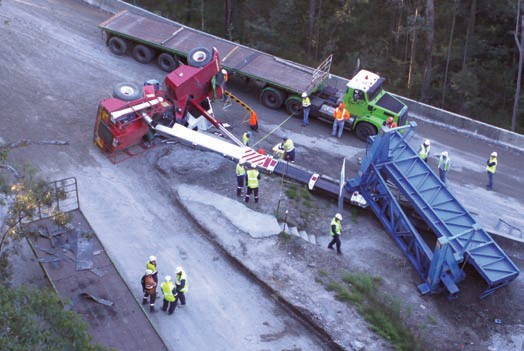Using mobile cranes in ‘pick and carry’ operations
The purpose of this Safety Alert is to remind persons conducting businesses and undertakings (PCBUs) that mobile cranes are designed to be used on firm and flat ground, when travelling with suspended loads (pick and carry).
Background
At a recent bridge construction project in NSW, a ‘pick and carry’ mobile crane moved across a slope whilst travelling with a suspended load. This reduced the crane’s lifting capacity and caused it to tip on its side.

Contributing factors
Preliminary findings indicate that the crane operators and engineer’s assessments of the lift and the travel path did not consider the dangers of carrying a load on a slope.
Action required
- Mobile cranes travelling with freely suspended loads should avoid slopes, unless a load is within the manufacturer’s allowable rated lifting capacities. That is, the total freely suspended load, including the mass of material and load handling equipment, that the crane can safely lift under ideal conditions at a given boom length and load radius. Cranes should be operated on firm level ground (to within 1 per cent gradient, 0.6°) with their tyres inflated to the correct pressure.
- Some crane manufacturers provide derating charts, which help to determine a crane’s rated lifting capacity on a certain side slope. For slopes that are allowed by a manufacturer, the following factors should be considered:
- Operations should be undertaken according to the crane manufacturer’s instructions – in particular, refer to the crane operations manual for consideration of any decrease in the rated capacity due to external influences i.e. deration
- Inspect ground conditions, especially after wet weather, before lifting and moving loads. The ground should be level and capable of supporting the crane and its load. Plan the path of travel before operating the crane. It may be necessary to improve ground conditions
- Crane operators and crane crew must be trained and competent in ‘pick and carry’ operations and have received the crane manufacturer’s information for this type of operation
- With ‘pick and carry’ operations, the load should be carried with the minimum boom length, as close to the ground as possible and moved at a comfortable walking pace
- When moving the load, attach tag lines to prevent load swing which can reduce the crane’s capacity by inducing a side load on the boom. These can be held by the dogman or attached appropriately
- The side slope inclinometer is to be used as a guide only. It is only accurate when the crane’s articulation is straight ahead with no load
- Consider the additional effect of wind loading, especially on loads with a large wind area
- Prepare a safe work method statement and implement risk control measures for any reduced lifting capacities
- Use rated lifting equipment, such as slings or spreader beams
- Except when the movement of a crane and its load is being directed by a dogman, the operator should be able to observe the hook, load attaching device and load. The dogman should be seen by the operator and should not be positioned between the load and the crane
- Cranes are also limited in their fore and aft slope rated lifting capacity when used in ‘pick and carry’ operations. Stay within the manufacturer’s limitations and follow any instructions. When climbing or descending a slope the centre of gravity of the suspended load moves towards the tipping point, thereby reducing the crane’s forward stability
- Operators should keep the load up-hill of the crane i.e. drive in reverse down a slope to keep the load close to the crane
- Operators should turn with a long radius, to reduce the articulation of the crane. Articulation reduces the rated capacity of the crane
- Arrangements should be made to keep non-crane crew personnel away from the vicinity of the lifting operation.
Further information
Legislation
Disclaimer
The information in this Safety Alert is from the Safety Alert, Using mobile cranes in ‘pick and carry’ operations, issued by WorkCover NSW in January 2013 (Catalogue number WC03919). NT WorkSafe does not warrant the information in this Safety Alert is complete or up to date and does not accept any liability to any person for the information in this report or as to its use.